 Uncanny X-Men #600 — Writer: Brian Michael Bendis; Art: Sara Pichelli, Mahmud Asrar, Stuart Immonen, Eris Anka, Chris Bachalo, David Marquez and Frazer Irving
Uncanny X-Men #600 — Writer: Brian Michael Bendis; Art: Sara Pichelli, Mahmud Asrar, Stuart Immonen, Eris Anka, Chris Bachalo, David Marquez and Frazer Irving
Let’s start with this — not a beginning, but an ending, the conclusion to Bendis’s three-year run on both Uncanny and All-New X-Men. It’s mostly everybody attempting to perform an intervention on Henry McCoy, calling him to task for all his messing with the time-space continuum, after which he kind of stomps out. That’s basically it, but the various flashbacks and little set pieces play to Bendis’s dialogue and character strengths, and the division into small sections lets pretty much all the artists who’ve contributed to the run get a final moment in the spotlight. The denouement, naturally, belongs to Chris Bachalo, who’s contributed the most stories, always of a very high quality: it involves Scott Summers gathering all the mutants on earth together, and wraps with a suitably optimistic tone (one that’s immediately dashed in Extraordinary X-Men #1, but we’ll get to that in the next review…). There’s also a one-page farewell editorial from Bendis, and a 17-pg. Iceman solo story from the Bizarre Adventures magazine back in the early ’80s: it’s in black and white, and features George Perez pencils and Alfredo Alcala inks over a Mary Jo Duffy script. Now that the whole run is over, you’ll all have to decide where this version of the characters fits into their overall history: I think it’s definitely been the best of the last decade or so, but that may be damning it with faint praise: how many other good X-Men runs have there been in the 21st century?
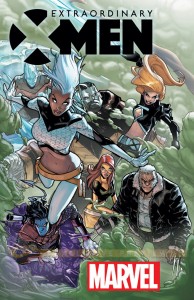 Extraordinary X-Men #1 — Writer: Jeff Lemire; Pencils: Humberto Ramos; Inks: Victor Olazaba; Colors: Edgar Delgado
Extraordinary X-Men #1 — Writer: Jeff Lemire; Pencils: Humberto Ramos; Inks: Victor Olazaba; Colors: Edgar Delgado
Deadpool #1 — Writer: Gerry Duggan; Pencils: Mike Hawthorne; Inks: Terry Pallot; Colors: Val Staples
Drax #1 — Writers: CM Punk and Cullen Bunn; Art: Scott Hepburn; Colors: Matt Milla
Hercules #1 — Writer: Dan Abnett; Art: Luke Ross; Colors: Guru-FX
Howard the Duck #1 — Writer: Chip Zdarsky; 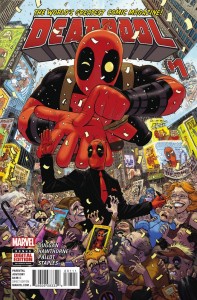 Pencils/Colors: Joe Quinones; Inks: Jow Rivera
Pencils/Colors: Joe Quinones; Inks: Jow Rivera
Nova #1 — Writer: Sean Ryan; Art: Cory Smith; Colors: David Curiel
The Vision #1 — Writer: Tom King; Art: Gabriel Hernandez Walta; Colors: Jordie Bellaire
The by-now-expected new crop of Marvel first issues. Extraordinary X-Men, as I mentioned, starts eight months after Secret Wars, and features a mutant world turned to crap: Scott Summers did some unspecified Bad Thing, and now everyone hates mutants and wants to shoot them; if that weren’t bad enough, those pesky terrigen mists from over in the Inhumans books are proving 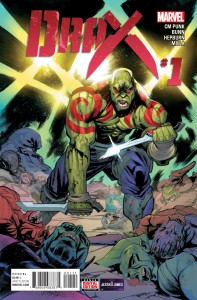 deadly to mutants, infecting them with some kind of “M-pox” and sterilizing them, so this generation will be the last. Uh-huh… we’ve heard all of this before, of course, and so the premise causes some eye-rolling, but those events do provide enough drama to get everything started, and the Lemire/Ramos team offers some smart writing and very good-looking art (if you don’t mind Ramos’s preference for the cartoony over the realistic). Let’s call it an encouraging start despite its tired premise — and there’s a last-page character reveal that ups the ante, even though everyone who’s been reading the Secret Wars stuff will see it coming from a mile away. Deadpool changes things up, too — it uses the “eight months later” gap to introduce a Wade who’s, somehow, now respected and admired
deadly to mutants, infecting them with some kind of “M-pox” and sterilizing them, so this generation will be the last. Uh-huh… we’ve heard all of this before, of course, and so the premise causes some eye-rolling, but those events do provide enough drama to get everything started, and the Lemire/Ramos team offers some smart writing and very good-looking art (if you don’t mind Ramos’s preference for the cartoony over the realistic). Let’s call it an encouraging start despite its tired premise — and there’s a last-page character reveal that ups the ante, even though everyone who’s been reading the Secret Wars stuff will see it coming from a mile away. Deadpool changes things up, too — it uses the “eight months later” gap to introduce a Wade who’s, somehow, now respected and admired 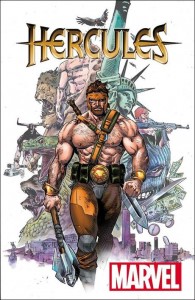 (which is apparently why he’s now co-starring over in Uncanny Avengers), and has employed a bunch of other characters (continuity experts will have fun identifying all of them) to wear the Deadpool costume and become part of a “Heroes for Hire” deal. The Hawthorne/Pallot art is OK, if not particularly inspired, and having Duggan continue as writer from the previous run means that fans, and sales, should continue at a high level. Drax continues to test the limits of Guardians of the Galaxy fandom (just how many different books with solo or team-up versions of the group can Marvel turn out, anyway?) , since the Big Green Guy Who Isn’t The Hulk isn’t exactly the most complex character, but Punk and Bunn
(which is apparently why he’s now co-starring over in Uncanny Avengers), and has employed a bunch of other characters (continuity experts will have fun identifying all of them) to wear the Deadpool costume and become part of a “Heroes for Hire” deal. The Hawthorne/Pallot art is OK, if not particularly inspired, and having Duggan continue as writer from the previous run means that fans, and sales, should continue at a high level. Drax continues to test the limits of Guardians of the Galaxy fandom (just how many different books with solo or team-up versions of the group can Marvel turn out, anyway?) , since the Big Green Guy Who Isn’t The Hulk isn’t exactly the most complex character, but Punk and Bunn 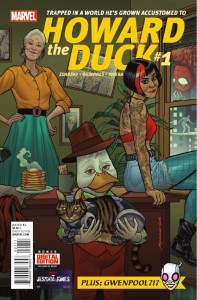 make a number of good moves: star the other Guardians, too, at least in the first 2/3 of the book, and keep the tone light and sideways-funny; mix in the art and (especially) the coloring, which combine to offer some nice-looking visuals, and this title should do OK. Hercules is another puzzling choice, since the Olympian strongman has never been able to sustain his own title for very long (although those Bob Layton mini-series in the ’80s were probably his high point), but Abnett’s another smart writer, and he offers an updated, savvy, street-level fighter who’s comfortable with both the modern and the mythological worlds. He also makes sure to offer Ross, a solid superhero-friendly artist, a couple of splash pages to really show his chops, and that and the book’s plentiful charm
make a number of good moves: star the other Guardians, too, at least in the first 2/3 of the book, and keep the tone light and sideways-funny; mix in the art and (especially) the coloring, which combine to offer some nice-looking visuals, and this title should do OK. Hercules is another puzzling choice, since the Olympian strongman has never been able to sustain his own title for very long (although those Bob Layton mini-series in the ’80s were probably his high point), but Abnett’s another smart writer, and he offers an updated, savvy, street-level fighter who’s comfortable with both the modern and the mythological worlds. He also makes sure to offer Ross, a solid superhero-friendly artist, a couple of splash pages to really show his chops, and that and the book’s plentiful charm 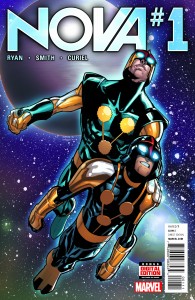 should be enough to bring readers back for more. Howard the Duck is another book that’s changed little from its brief previous incarnation, and Zdarsky and Quinones, if anything, are now even more comfortable with the Duck’s many scripting and artistic quirks, so it continues to be the best version of the character since Steve Gerber, his creator, died. Nova has a new creative team and a new setup — the teenage Sam is still the title character, but his dad is back, and also wears a Nova costume — but has most of the same flavor as the last volume of the series, with a soap-opera twist or two at the end to help shake things up. Of all the new
should be enough to bring readers back for more. Howard the Duck is another book that’s changed little from its brief previous incarnation, and Zdarsky and Quinones, if anything, are now even more comfortable with the Duck’s many scripting and artistic quirks, so it continues to be the best version of the character since Steve Gerber, his creator, died. Nova has a new creative team and a new setup — the teenage Sam is still the title character, but his dad is back, and also wears a Nova costume — but has most of the same flavor as the last volume of the series, with a soap-opera twist or two at the end to help shake things up. Of all the new 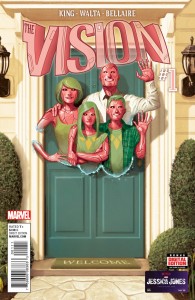 issues this week, though, Vision is the most interesting — it stars the long-time Avengers synthezoid, who’s moved to a Washington, DC suburb, built a synthezoid wife and two kids, and is attempting to live a typical American life — but is it real, or just an illusion? King does a lot more with this concept than I expected (including a daring, very Alan Moore-like narrative flash-forward), and Walta makes the suburban landscape just unsettling and spooky enough to work; pick this up if you get a chance, because I think it’s going to be one of those low-selling comics that becomes a cult favorite.
issues this week, though, Vision is the most interesting — it stars the long-time Avengers synthezoid, who’s moved to a Washington, DC suburb, built a synthezoid wife and two kids, and is attempting to live a typical American life — but is it real, or just an illusion? King does a lot more with this concept than I expected (including a daring, very Alan Moore-like narrative flash-forward), and Walta makes the suburban landscape just unsettling and spooky enough to work; pick this up if you get a chance, because I think it’s going to be one of those low-selling comics that becomes a cult favorite.
 Spider-Gwen #0 — Writer: Jason Latour; Art: Robbi Rodriguez; Colors: Rico Renzi
Spider-Gwen #0 — Writer: Jason Latour; Art: Robbi Rodriguez; Colors: Rico Renzi
Blade: Undead by Daylight #1 (of 1) — Writers: Marv Wolfman and Christopher Golden; Pencils: Gene Colan; Inks: Jack Abel, Tom Palmer and Mark Pennington
Two reprints, one new and one old: the Spider-Gwen reprints the very hard-to-find introduction of the character in Edge of Spider-Verse #2, and pads it 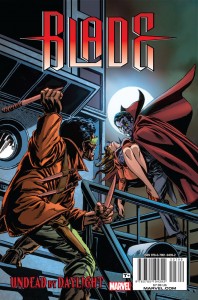 out with Latour’s full typed script for that issue; anyone who’s thinking about becoming a comics writer should get it just to see one example of how the format and stage directions work. Blade offers a big chunk of reprints: the vampire-fighting movie star’s first appearance in Tomb of Dracula #10, plus stories in #24 and #58, plus the first issue of his solo series. All have art by the great, great Gene Colan, one of the best horror artists in comics history, and, if you’ve never encountered them before, are a bargain at $7.99
out with Latour’s full typed script for that issue; anyone who’s thinking about becoming a comics writer should get it just to see one example of how the format and stage directions work. Blade offers a big chunk of reprints: the vampire-fighting movie star’s first appearance in Tomb of Dracula #10, plus stories in #24 and #58, plus the first issue of his solo series. All have art by the great, great Gene Colan, one of the best horror artists in comics history, and, if you’ve never encountered them before, are a bargain at $7.99
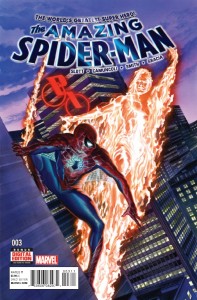 Amazing Spider-Man #3 — Writer: Dan Slott; Pencils: Giuseppe Camuncoli; Inks: Cam Smith; Colors: Marte Gracia
Amazing Spider-Man #3 — Writer: Dan Slott; Pencils: Giuseppe Camuncoli; Inks: Cam Smith; Colors: Marte Gracia
Invincible Iron Man #3 — Writer: Brian Michael Bendis; Art: David Marquez; Colors: Justin Ponsor
Doctor Strange #2 — Writer: Jason Aaron; Pencils/Colors: Chris Bachalo; Inks: Tom Townsend, Al Vey and Mark Irwin; Colors: VC’s  Cory Petit
Cory Petit
A trio of recent relaunches, still in their low single digits, and they’re three of Marvel’s best books right now (of course, Marvel hasn’t published that many of their new line of comics yet, but still…). Amazing Spider-Man has the newly-rich, Bruce-Waynified Peter Parker buying the Baxter Building, dealing with a ticked-off Johnny Storm,  and dropping a few hints about what happened to the FF at the end of Secret Wars, while Iron Man continues Tony’s fight with Madame Masque and guest-stars Doctor Strange, just long enough for an amusing scene with the ebullient Stark and the stoic master of the mystic arts. Strange, in his own book, continues to benefit from the Aaron/Bachalo team; its first two issues combine to make a satisfying story, set up some plot threads for future threats, and, thanks to Bachalo, look better than any other book on the stands this week.
and dropping a few hints about what happened to the FF at the end of Secret Wars, while Iron Man continues Tony’s fight with Madame Masque and guest-stars Doctor Strange, just long enough for an amusing scene with the ebullient Stark and the stoic master of the mystic arts. Strange, in his own book, continues to benefit from the Aaron/Bachalo team; its first two issues combine to make a satisfying story, set up some plot threads for future threats, and, thanks to Bachalo, look better than any other book on the stands this week.
 Justice League: The Darkseid Trilogy: Superman #1 (of 12) — Writer: Francis Manapul; Art: Bong Dazo; Colors: Hi-Fi
Justice League: The Darkseid Trilogy: Superman #1 (of 12) — Writer: Francis Manapul; Art: Bong Dazo; Colors: Hi-Fi
Justice League: The Darkseid Trilogy: Flash #1 (of 1) — Writer: Rob Williams; Art: Jesus Merino; Colors: Guy Major
These are sort-of interesting: Geoff Johns has been doing a “Darkseid War” over in Justice League, and the various JLAers have been affected by Apocalips and powered-up, but now they’re New God-like and lack human morality (I liked this plot a little better when it was called “Black Vortex” over at Marvel last summer…); these one-shots are meant to explore their transformations in depth and then wrap back into the next Justice League in a couple of weeks. Quick summaries: 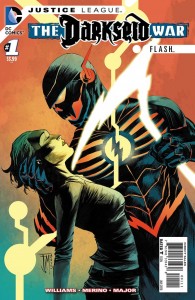 Superman has been supercharged by Apokalipsian solar energy, looks like a negative version of himself and is pretty much a dick, while Flash, who has merged with the Black Racer to become an avatar of Death, runs around being chased by its skeletal personification, has one of those why-we-need-entropy realizations and, eventually, chases Death back. The visuals on the negative-Superman are cool (and this is another book that’s really enhanced by the coloring), but the Flash/Death mashup is even better, with Merino’s art providing the detail and heft to make it work; as one-shots, instead of five-issue mini-series, these are both just the right size for their concepts.
Superman has been supercharged by Apokalipsian solar energy, looks like a negative version of himself and is pretty much a dick, while Flash, who has merged with the Black Racer to become an avatar of Death, runs around being chased by its skeletal personification, has one of those why-we-need-entropy realizations and, eventually, chases Death back. The visuals on the negative-Superman are cool (and this is another book that’s really enhanced by the coloring), but the Flash/Death mashup is even better, with Merino’s art providing the detail and heft to make it work; as one-shots, instead of five-issue mini-series, these are both just the right size for their concepts.
 Unfollow #1 — Writer: Rob Williams; Art: Mike Dowling; Colors: Guinton Winter
Unfollow #1 — Writer: Rob Williams; Art: Mike Dowling; Colors: Guinton Winter
Survivor’s Club #2 — Writers: Lauren Beukes and Dale Halvorsen; Art: Ryan Kelly; Colors: Eva de la Cruz
These books are part of DC’s effort to recreate the quirky-cool mini-series buzz that their Vertigo imprint had a decade or two ago (and today is supplied by all those creator-owned Image books). Unfollow has a dying tech genius, who made $17 billion creating a Twitter-like social medium, dividing  that money among 140 people chosen at random; the first issue follows a couple of these 140 characters (get it?) as they receive the news. Entertaining but a little cliched, it’s helped by Dowling’s loose, expressive art. Survivor’s Club is a little stranger; two issues in, I’m still not clear about the plot, which seems to involve a, literally, viral video game that infects people with anger, especially because this issue spends more time on developing its offbeat characters (the girl who splits her consciousness between a couple of doll-like bodies is the most well-conceived, which is probably why she’s featured on the cover).
that money among 140 people chosen at random; the first issue follows a couple of these 140 characters (get it?) as they receive the news. Entertaining but a little cliched, it’s helped by Dowling’s loose, expressive art. Survivor’s Club is a little stranger; two issues in, I’m still not clear about the plot, which seems to involve a, literally, viral video game that infects people with anger, especially because this issue spends more time on developing its offbeat characters (the girl who splits her consciousness between a couple of doll-like bodies is the most well-conceived, which is probably why she’s featured on the cover).
 Monstress #1 — Writer: Marjorie Liu; Art/Colors: Sana Takeda
Monstress #1 — Writer: Marjorie Liu; Art/Colors: Sana Takeda
Johnny Red #1 (of 8) — Writer: Garth Ennis; Art: Keith Burns; Colors: Jason Wordie
Klaus #1 — Writer: Grant Morrison; Art/Colors: Dan Mora
James Bond #1 — Writer: Warren Ellis; Art: Jason 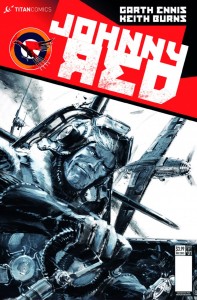 Masters; Colors: Guy Major
Masters; Colors: Guy Major
Joe Golem: Occult Detective #1 (of 5) — Writers: Mike Mignola and Christopher Golden; Art: Patric Reynolds; Colors: Dave Stewart
Citizen Jack #1 — Writer: Sam Humphries; Art: Tommy Patterson; Colors: Jon Alderin
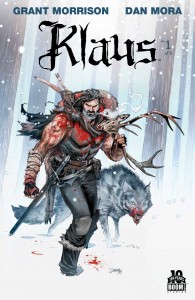 Six indy first issues: Monstress is the best book of the week, almost 70 pages of lush high fantasy about a magic-based matriarchal world separated into warring factions who fought a decisive battle maybe ten years ago; ever since, the winning side has enslaved and tortured the losers — except that now the daughter of one of the loser leaders is coming to the winners’ stronghold, with a plan for revenge… this is all illustrated by Takeda in a shadowy-manga style that’s detailed and often lovely, while Liu’s story offers a deep, well-realized world that makes us feel
Six indy first issues: Monstress is the best book of the week, almost 70 pages of lush high fantasy about a magic-based matriarchal world separated into warring factions who fought a decisive battle maybe ten years ago; ever since, the winning side has enslaved and tortured the losers — except that now the daughter of one of the loser leaders is coming to the winners’ stronghold, with a plan for revenge… this is all illustrated by Takeda in a shadowy-manga style that’s detailed and often lovely, while Liu’s story offers a deep, well-realized world that makes us feel  like we’ve known the characters for years. Almost any other creators would have stretched this into a four- or even six-issue mini-series, but the whole thing can be yours for $4.99. Johnny Red is Garth Ennis reviving one of those ancient British-magazine adventure strips he read as a kid, about a WW II American flying ace working with a Russian squadron at the Seige of Stalingrad; it’s got the same Frontline Combat feel as his War Stories comics. Klaus is Grant Morrison
like we’ve known the characters for years. Almost any other creators would have stretched this into a four- or even six-issue mini-series, but the whole thing can be yours for $4.99. Johnny Red is Garth Ennis reviving one of those ancient British-magazine adventure strips he read as a kid, about a WW II American flying ace working with a Russian squadron at the Seige of Stalingrad; it’s got the same Frontline Combat feel as his War Stories comics. Klaus is Grant Morrison  doing the origin of Santa Claus, with a medieval walled city surrounded by forest, ruled by a Joffrey-on-Game-Of-Thrones-like child despot, egged on by his evil advisor and sketchy mother, and challenged by a noble woodsman who turns out to be Guess Who; if you like the way he’s rendered on the cover, you’ll probably like the book. James Bond is Warren Ellis doing James Bond, which, really, is all you need to know as long as the art’s half-decent; it is. Joe Golem is based on the
doing the origin of Santa Claus, with a medieval walled city surrounded by forest, ruled by a Joffrey-on-Game-Of-Thrones-like child despot, egged on by his evil advisor and sketchy mother, and challenged by a noble woodsman who turns out to be Guess Who; if you like the way he’s rendered on the cover, you’ll probably like the book. James Bond is Warren Ellis doing James Bond, which, really, is all you need to know as long as the art’s half-decent; it is. Joe Golem is based on the 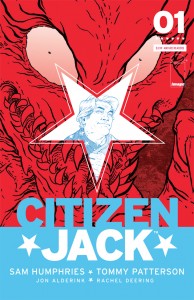 Mike Mignola-authored novel about an alternate Earth where New York City got flooded in the 1920s and all sorts of strange creatures live there now; the title character is a tough-guy private detective who, since it’s a Mignola book, of course handles occult and monster cases. Citizen Jack is a refreshing chaser to the rest of these, because it’s a comedy, about a small-town huckster who makes a deal with Satan to become President of the United States; it takes its time on the set-up, but its hapless protagonist, simultaneously appealing and appalling as he spends most of the book hanging out in his bathrobe, makes the premise click.
Mike Mignola-authored novel about an alternate Earth where New York City got flooded in the 1920s and all sorts of strange creatures live there now; the title character is a tough-guy private detective who, since it’s a Mignola book, of course handles occult and monster cases. Citizen Jack is a refreshing chaser to the rest of these, because it’s a comedy, about a small-town huckster who makes a deal with Satan to become President of the United States; it takes its time on the set-up, but its hapless protagonist, simultaneously appealing and appalling as he spends most of the book hanging out in his bathrobe, makes the premise click.
 Paper Girls #2 — Writer: Brian K. Vaughan; Art: Cliff Chiang; Colors: Matt Wilson
Paper Girls #2 — Writer: Brian K. Vaughan; Art: Cliff Chiang; Colors: Matt Wilson
We Stand on Guard #5 — Writer: Brian K. Vaughan; Art: Steve Skroce; Colors:Matt Hollingsworth
Two by Vaughan, who’s one of our best creator-owned writers right now (his and Fiona Staples’ Saga is a perennial best-seller); his books all give their artists plenty of opportunities to shine, and have at least one or two head-snapping WTF moments every issue. Paper Girls has its four plucky title characters facing some kind of timequake/alien 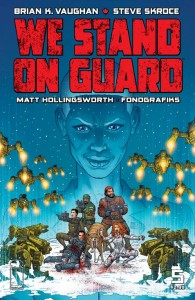 invasion/incursion in their Spielbergian suburban neighborhood, and, sure enough, there’s an awesome double-page centerspread for Chiang, and a last page that ends, literally, with a bang. We Stand on Guard continues his sf/future tale about the US invading Canada (with the Canadian resistance fighters as the heroes), and it, too, gives its artist a couple of moments to really let loose, with a quiet splash at the beginning, some violent high-tech weaponry in the middle, and another potentially-explosive last page. These are both good-looking, interesting, well-made comics, and worth a look.
invasion/incursion in their Spielbergian suburban neighborhood, and, sure enough, there’s an awesome double-page centerspread for Chiang, and a last page that ends, literally, with a bang. We Stand on Guard continues his sf/future tale about the US invading Canada (with the Canadian resistance fighters as the heroes), and it, too, gives its artist a couple of moments to really let loose, with a quiet splash at the beginning, some violent high-tech weaponry in the middle, and another potentially-explosive last page. These are both good-looking, interesting, well-made comics, and worth a look.
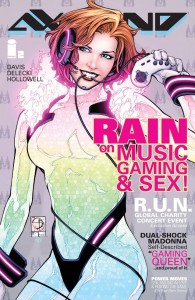 Axcend #2 — Writer/Pencils: Shane Davis; Inks: Michelle Delecki
Axcend #2 — Writer/Pencils: Shane Davis; Inks: Michelle Delecki
Dark Corridor #4 — Creator: Rich Tommaso
Stray Bullets: Sunshine and Roses #9 — Creator: David Lapham
 Velvet #12 — Writer: Ed Brubaker; Art: Steve Epting; Colors: Elizabeth Breitweiser
Velvet #12 — Writer: Ed Brubaker; Art: Steve Epting; Colors: Elizabeth Breitweiser
The rest of the indies — Axcend is another comic about a video game, one whose top players are transforming into their online avatars; it’s setting up a big global-battle story, but the early issues are establishing the main characters  and their relationships, and there’s just enough good art moments and plot twists to make it work. The other three books are all film-noir takeoffs: Dark Corridor features Tommaso’s cool-looking undergroundish art indulging in an eleven-page car chase, but also includes a backup story with more actual plot and variety; both take place in his Sin City-like urban landscape. Stray Bullets is David Lapham’s longtime
and their relationships, and there’s just enough good art moments and plot twists to make it work. The other three books are all film-noir takeoffs: Dark Corridor features Tommaso’s cool-looking undergroundish art indulging in an eleven-page car chase, but also includes a backup story with more actual plot and variety; both take place in his Sin City-like urban landscape. Stray Bullets is David Lapham’s longtime 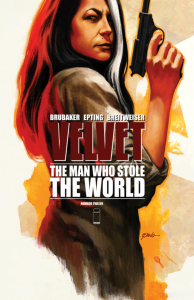 tribute to the genre, with his sprawling cast of characters all engaging in bad behavior and questionable choices; it’s wrapping up a long plot that’s sure to end up with many of them dead or damaged, which is of course part of the fun. Velvet is a smooth spy thriller, with a kickass heroine who’s been set up as a traitor and is fighting to clear her name; the Brubaker/Epting team gives it a cinematic style that plays like one of the better Bond movies, and its high-class entertainment makes it the perfect conclusion to this week’s offerings.
tribute to the genre, with his sprawling cast of characters all engaging in bad behavior and questionable choices; it’s wrapping up a long plot that’s sure to end up with many of them dead or damaged, which is of course part of the fun. Velvet is a smooth spy thriller, with a kickass heroine who’s been set up as a traitor and is fighting to clear her name; the Brubaker/Epting team gives it a cinematic style that plays like one of the better Bond movies, and its high-class entertainment makes it the perfect conclusion to this week’s offerings.



